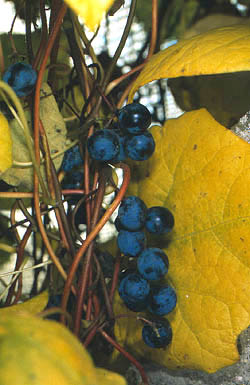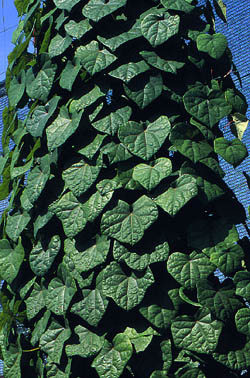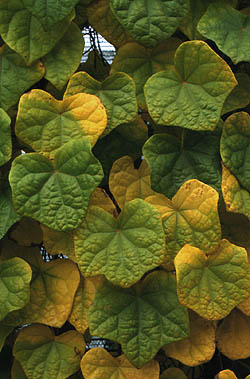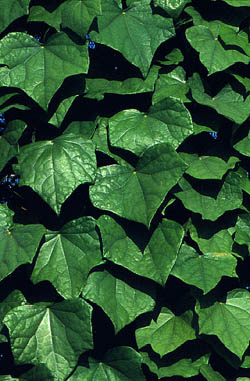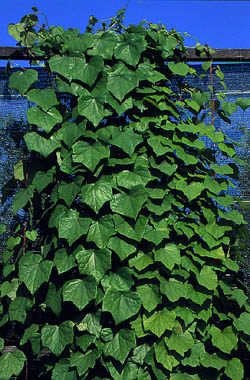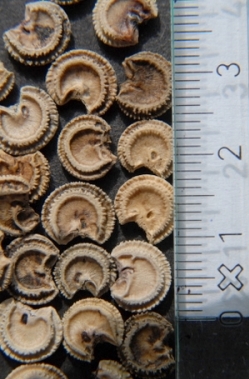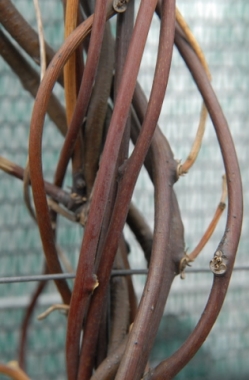MOONSEED (MENISPERMUM) – A LITTLE-KNOWN, VALUABLE CLIMBER
The name, Moonseed of this semi-woody vine comes from the shape of the seed, which resembles a crescent moon. There are known two species of the genus: Common Moonsed (Menispermum canadense) and Asian moonseed (Menispermum davuricum).
Szczepan Marczyński
- Menispermum davuricum – fruits and leaves in autumn – photo Sz. Marczyński
The plants of the genus have slender stems that twine tightly round the supports and attain a height of 3 – 5 m. Tiling leaves are their main attraction: oval to heart-shaped, 10 – 18 cm in diameter, with 5 -7 shallow angular lobes and well visible venation. Deep green on the upper side and light green on the bottom during the vegetation period, they turn vividly yellow in autumn. Moonseed can climb up a fence, various types of meshes or trellises and create an excellent screen or a monochrome background for other plants with brightly coloured flowers. It looks charming overgrowing small trees. It propagates by root stolons, so it shouldn’t be planted in close proximity to perennial beds or other small plants.
Menispermum is a bisexual plant. Inconspicuous, green yellow flowers, gathered in terminal clusters appear in June-July. Female plants, if grown in the vicinity of the male plants, set interesting, violet-black, small, round fruits, gathered in loose clusters. The berries are poisonous.
Moonseed is generally healthy and only sporadically attacked by diseases or pests. Quite undemanding, it will grow well even in not very rich and moderately moist soil. It prefers sunny sites. Generally frost-hardy (zones 5B-9), but in very severe winters the stems may freeze back to the ground. This doesn’t pose a problem, however, as the plant will shoot vigorously the following spring. No special pruning is required, but as it’s difficult to cut dead stems from the tangle of the shoots, it’s advisable to cut back the whole plant at the ground level every 2 – 3 years.
Out of the two know species, Asian moonseed (Menispermum davuricum) is more attractive. It has striking, large (10 – 20 cm in diameter), tiling leaves that are heart-shaped, rounded at the tip and have 3 – 5 barely discernible lobes, which can sometimes give the impression that the leaves have a form of a pentagon. The upper side is dark green and glossy with clearly visible veining, the underside blue-green, and in autumn the leaves turn bright yellow. Asian Moonseed is native to eastern Siberia, Japan and China, where it typically occurs in muddy soil along stream banks and in thickets.
Common Moonseed (Menispermum canadense) is native to north-eastern part of America. The leaves are oval to heart-shaped, with 3 – 7 angular lobes that are pointed at the tips. They are deep green on the upper side, with a lighter hue on the underside, and turn yellow in autumn.
- Menispermum davuricum – on a fence (summer) – photo Sz. Marczyński
- Menispermum davuricum – leaves in late summer – photo Sz. Marczyński
- Menispermum canadense – leaves in summer – photo Sz. Marczyński
- Menispermum canadense on a fence (summer) – photo Sz. Marczyński
- Menispermum davuricum – seeds – photo Sz. Marczyński
- Menispermum davuricum – stems in winter – photo Sz. Marczyński

